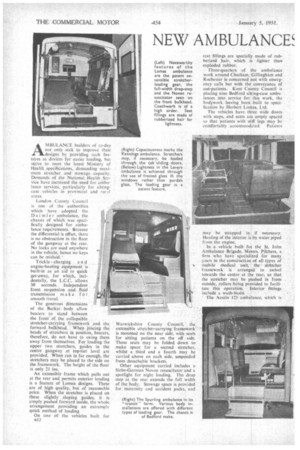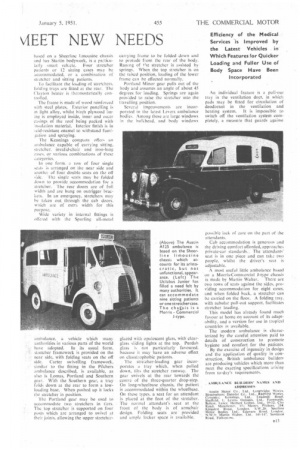NEW AMBULANCE viEET NEW NEEDS
Page 46

Page 47

If you've noticed an error in this article please click here to report it so we can fix it.
AMBULANCE builders of to-day not only seek to improve their designs by providing such featdres as devices for easier loading, but strive to meet the latest Ministry of Health specifications, demanding maximum stretcher and• stowage capacity. Demands of the National HealthService have increased the need for ambulance services, particularly for sittingcase vehicles in provincial and rur.11
areas. .
London County Council is one of the authorities which ' have adopted the .Da im 1 er ambulance, the chassis of which was specifically designed for ambulance requirements. Because the differential is offset, there is no obstruction in the floor of the gangway at the rear. No locks are used anywhere in the vehicle, hence no keys can be mislaid.'
Trickle charging and engine-heating equipment is built-in as an aid to quick get-away, for which, incidentally, the L.C.C. allows 30 seconds. Independent front suspension and fluid transmission make for smooth travel.
The generous dimensions of the Barker body allow bearers to stand between • the front of, the collapsible _ stretcher-carrying framework and the forward bulkhead. When Placing the heads of stretchers in position, bearers, therefore, do not have to swing them away from themselves. For loading the upper two stretchers, guides in the centre gangway at top-tier level are provided. When run in far enough, the stretchers may be placed to the side on the framework. The height of the floor is only 21 ins.
An extensible frame which pulls out it the rear and permits exterior loading is a feature of Lomas designs. These are of high quality, but of reasonable price. When the stretcher is placed on these slightly sloping guides, it is simply pushed forward inside, the whole arrangement providing an extremely quick method of loading On one of the vehicles built for 1312 Warwickshire County Council, the extensible stretcher-carrying framework is mounted on the near side, with seats for sitting patients on the off side. These seats may be folded down to make space for a second stretcher, whilst a third and a fourth may be carried above on each side, suspended from detachable brackets.
Other equipment carried includes a Siebe-Gorman Novox resuscitator and a spotlight for night loading. The drop step at the rear extends the full width of the body. Stowage space is provided for maternity and accident packs, and seat fillings are specially made of rubberized hair, which is lighter than exploded rubber.
Three-quarters of the ambulance work around Chatham, Gillingham and Rochester is concerned not with emergency calls but with the conveyance of out-patients. Kent County Council is placing nine Bedford sitting-case ambit. lances into service for this work, the bodywork having been built to specification by Herbert Lomas, Ltd.
The vehicles have three wide doors with steps, and seats are amply spaced so that patients with stiff legs may be comfortably accommodated. Patients may be strapped in if necessary. Heating of the interior is by water piped from the engine.
In a vehicle built for the St. John Ambulance Brigade, Messrs. Pilchers, a • firm who have specialized for many years in the construction of all tyres of mobile medical unit, the stretcher framework is arranged to swivel towards the centre at the rear, so that the stretcher may be pushed in from outside, rollers being provided to facilitate this operation. Interior fittings include a wash-basin.
The Austin 125 ambulance, which is based on a Sheerline limousine chassis and has Startin bodywork, is a particularly smart vehicle. Four stretcher patients or 12 sitting cases may be accommodated, or a combination of stretcher and sitting patients.
To facilitate the loading of stretchers. folding trays are fitted at the rear. The Clayton heater is thermostatically controlled.
The frame is made of wood reinforced with steel plates. Exterior panelling is in light alloy, whilst birch plywood lining is employed inside, inner and oteer casings of the roof being packed with insulation material. Interior finish is in .1.c:id-resistant enamel to withstand fumigation and spraying.
The Kennings company offers an ambulance capable of carrying sitting. stretcher, invalid-chair and iron-lung eases, or various combinations of these categories.
In one form. a row of four single scats is arranged on the near side and another of four double seats on the off side. 1 he single seats may be folded Joan to provide accommodation for a Aretcher. 'I he rear doors are of •full width and are hung on outrigger brackets. In an emergency, stretchers may be taken out through the cab doors, which are of extra width for this purpose.
Wide variety in internal fittings is offered with the Spurlinc
Ambulance, a vehicle which many authorities in various parts' of the world have adopted. In its usual form. stretcher framework is provided on the near side, with folding seats on the off side. Carter swivelling framework, similar to the fitting in the Pilchers ambulance described, is available, as also is Lomas, Portland and Southern gear. With the Southern gear, a tray folds down at the rear to form a loading base.When pushed up it locks the stretcher in position.
"I be Portland gear may he used to accommodate two stretchers in tiers. The top stretcher is supported on four posts which are arranged to swivel at their johys, allowing the upper stretcher
carrying frame to be folded down and to protude from the rear of the body. Rais:ng of t'te stretcher is assisted by springs. When the top stretcher is on the raised position, loading of the lower frame can be effected normally.
Portland Minor gear pulls out of the body and assumes an angle of abciut 45 degrees for loading. Springs are again provided to raise the stretcher into the travelling position.
Several improvements are incorporated in the latest Levers ambulance bodies. Among these are large windows in the bulkhead. and body windows
glazed with opalescent glass. with.clearglass sliding lights at the top. Purdah glass is not particularly favoured. because it inay have an adverse effect on claustrophobic patients.
The stre;cher-loading gear incorporates a tray which, when pulled down, tills the stretcher runway. The gear swivels at the rear towards the centre of the three-quarter drop-step. On long-wheelbase chassis, the patient is accommodated within the wheelbase. On these types, a seat for an attendant is placed at the foot of the stretcher. The normal attendant's . seat at the front of the body is of armchair design. Folding seats arc provided and ample locker space is available. An individual feature is a pull-ow tray in the ventilation duct, in which pads may be fitted for circulation of deodorant in the ventilation and heating system. It is impossible to switch off the ventilation system completely, a measure that guards against
possible lack of care on the part of the attendants.
Cab accommodation is generous and the driving comfort afforded; approaches private-car standards.. The -attendants' scat is in one piece and can take two people, whilst the driver's seat is adjustable.
A most useful little ambulance based on a Morris-Commercial J-type chassis is made by Martin Walter. There are two rows of seats against the sides, providing accommodation for eight cases, and when folded back, a stretcher can be carried on the floor. A folding tray. with tubular pull-out support. facilitates stretcher loading.
This model has already found much favour at home on account of its adaptability, and a version for use in tropical countries is available.
The modern ambulance is characterized by the careful attention paid to details of construction to promote hygiene and comfortfor the patients. By the exercise of ingenuity in design and the application of quality in construction, British ambulance builders are producing vehicles which more than meet the exacting specifications arising front to-day's requirements.




















































































